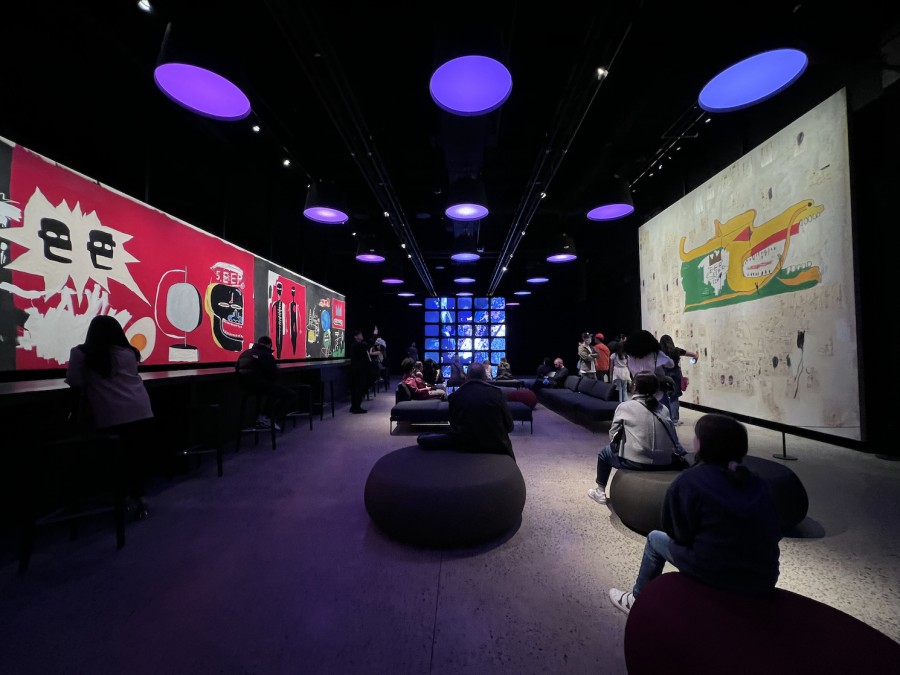Review: Must-see ‘Jean-Michel Basquiat: King Pleasure’ puts Basquiat back in context
Organized and curated by the late artist’s family, “Jean-Michel Basquiat: King Pleasure” offers a new perspective on Basquiat’s life and art.
“Jean-Michel Basquiat: King Pleasure” opened on April 9 in the Starrett-Lehigh Building in Chelsea. (Photo by Elle Liu)
May 3, 2022
Who is Jean-Michel Basquiat? Most of the world associates him with the New York arts scene of the early 1980s. Since his untimely death in 1988, his work has catapulted in value to record-shattering prices.
Basquiat’s family is now sharing a new perspective on the late, great artist’s life and works with the exhibition “Jean-Michel Basquiat: King Pleasure,” which opened on Sunday, April 9, in the Starrett-Lehigh Building in Chelsea. Basquiat’s sisters, Lisane Basquiat and Jeanine Heriveaux, who have managed the Basquiat Estate since 2013, organized and curated the exhibition.
Jean-Michel Basquiat’s oeuvre of revolutionary artworks propelled him to meteoric fame in the 1980s. He transubstantiated his experience as a Black man in the United States into artwork. Basquiat’s pieces are transgressive and visually poetic, having a pictorial quality while combining elements of abstraction and graffiti to provide commentary on subjects such as racism and class struggle.
Never before have this many Basquiat artworks been presented. In fact, most of the 200 artworks and artifacts on view have been in storage for decades and have never been shown to the public.
The 15,000-square-foot exhibition space was designed by acclaimed architect David Adjaye. Adjaye created synergetic galleries that highlight the artwork in paced, sectioned chapters, each focusing on a specific period of Basquiat’s life.
Beginning in 1960, the exhibition first displays Basquiat’s birth announcement: a yellowed rectangular paper with small, time-worn text. Born to a Haitian father and a Puerto Rican mother, Basquiat grew up in a multicultural household. In his formative years, exposure to many cultures across the Black Diaspora engendered a taste for cultural exploration that is visible in his art. The exhibition also highlights how informative music was to Basquiat’s early artistry. His first musical influence was his dad’s jazz record collection.
As the exhibition progresses, viewers can watch the artist come into his own. Early photos of a young Basquiat with his family and undated drawings taken from adolescent sketchbooks are displayed. On one gallery wall, a video is played in which his sister Jeanine tells the story of how her brother persuaded her to jump off an armoire with an umbrella and try to fly like Mary Poppins. These intimate touches throughout this exhibition coupled with its immersive design create a new depth and level of profundity that links the artist’s life to his works.
Through these early works, one can see the young artist finding his now incredibly recognizable voice, whether it’s cartoon-like characters with dialogue in “Untitled (Yup, he’s on the Moon Alright),” or mapping out a family tree in “Untitled (No Summer Hot Water Ossning).” Even his early, casual works are imbued with the distinct dynamism and confident hand that Basquiat is known for.
1982 was a pivotal year for Basquiat’s career as he exploded onto the art scene, and this landmark year is highlighted in the gallery titled “World Famous.” The paintings in this gallery are colorful, vibrant and visually confrontational. Violent, anguished brushstrokes fill the canvas of works like “Untitled” (1982), which also features a skull and three-pointed crown — motifs that would later become intrinsic to his brand.
Perhaps the most impressive installment of the exhibition is the reconstruction of three spaces important to Basquiat’s life: the living and dining room of the artist’s childhood home in Boerum Hill, his Great Jones Street studio and the Palladium nightclub.
The Boerum Hill home replica is quaint and cozy, with original ephemera included. A projector beams childhood photos of Basquiat and his family onto a wall of the living room, playing a video of Basquiat as a young boy, smiling with a toy plane in hand.
In the Great Jones Street Studio, where Basquiat lived from 1983 until his death, canvases are spread out on the ground and paintings lean casually against the walls. A TV plays in the corner, surrounded by stacks of Basquiat’s personal VHS collection. On a plywood table, among paint and paintbrushes, lie vinyl jazz records, books and a portable keyboard. Fresh cigarette butts lie in an ashtray. The studio is perhaps a sanitized representation of an artist’s organized chaos. Still, the distinct clarity in his artworks show.
A recreation of The Michael Todd Room of the Palladium nightclub closes the exhibition and is designed to radiate unadulterated joy. Inside, TV screens display photos of Basquiat at the club, partying with friends as a Blondie song plays overhead. “Nu-Nile,” a 10-meter-wide Basquiat masterpiece commissioned by the nightclub in 1985, spans an entire wall. Seeing at such proximity allows for the patron to study the details; the surety of the brushstrokes with their graffiti-derived angularity and the richness of the scarlet paint.
The exhibition is, in many ways, a retrospective, often evoking the bittersweet feeling of seeing the fruits of a forceful and enigmatic life that was tragically cut short.
Yet, the exhibition ends on a positive note. “He was huge energy entering this world,” reads the gallery placard. “Jean-Michel Basquiat: King Pleasure” is elegantly executed, offering up a biography that brings new depth to the understanding of both Basquiat’s life and artistry.
“He was someone’s brother and uncle and cousin and nephew,” says Lisane in one of the gallery videos. “If Jean-Michel were to sit here, it wouldn’t be about any of that,” referencing the financial value his paintings now hold. “It would just be about the fact that I miss him.”
Contact Elle Liu [email protected].



























































































































































